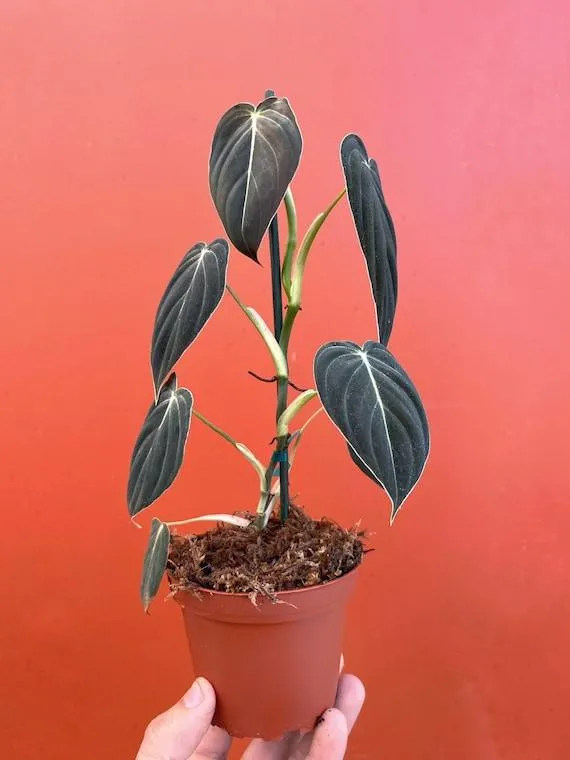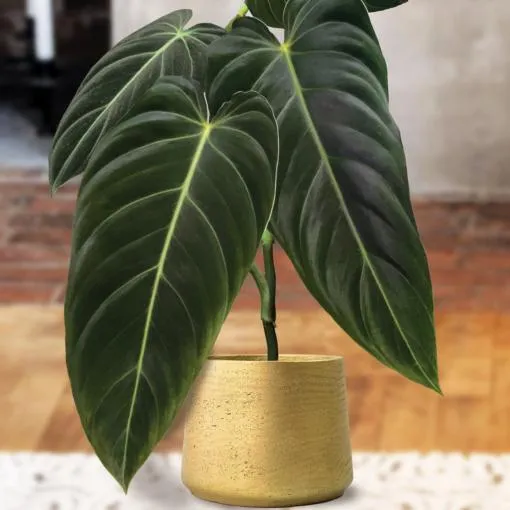Everything You Need to Know About Philo melanochrysum
Philo melanochrysum, commonly known as the golden creeping fig, is a beautiful and fascinating climbing plant native to Southeast Asia. As an avid gardener, I’ve had many wonderful experiences growing and caring for this lovely vine over the years. In this article, I’ll tell you basically everything I’ve learned about Philo melanochrysum from my own experience as well as from consulting expert sources.
Identification and Appearance
- Leaves – Dark green and heart-shaped, laying flat against surfaces.
- Stems – Woody and twining, capable of rapid growth to reach 20 feet or more.
- Flowers – Insignificant and greenish-yellow.
- Fruit – Small and purple or black when ripe, containing numerous seeds.
But the real showstopper is the coloration. As the name suggests, Philo melanochrysum has leaves splashed or mottled with attractive golden yellow or gold patches when grown in bright, indirect light. It’s sort of like a shimmering work of art you can grow right on your walls! The colors are stunning, to be honest. No wonder it’s such a popular vine.
Growing Conditions
Philo melanochrysum thrives in conditions similar to its native habitat – namely warm, humid climates with tropical temperatures between 65 to 85 degrees Fahrenheit. It can tolerate some shade, but the brighter the light, the more vibrant the golden splashes will be. Kind of a no-brainer, right? The soil should be well-draining but constantly moist. Neglecting watering is a sure way to basically kill this vine.
It’s an incredibly easy plant to grow in USDA plant hardiness zones 9-11. However, with a bit of care, it can also be grown as a houseplant in cooler zones. I’ve managed to keep mine going indoors year after year in zone 6 with the help of grow lights in winter. The trick is simulating those tropical conditions by providing humidity. Mist the foliage frequently if growing indoors.
One drawback is that Philo melanoschrysum is basically not frost tolerant at all. Even a light frost can damage the leaves and stems. So in colder areas, it’s best to bring potted specimens indoors before the first hard freeze. Overwintering as a houseplant allows you to enjoy this beauty for many years to come, at least in my experience!
Fertilize weekly during the active growing season using a dilute water-soluble plant food. Basically anything labeled for foliage plants or orchids will work great. Increase feeding if you want maximum variegation. Repot only when the roots have filled the container. Philo melanoschrysum is kind of a drama queen about repotting and may drop leaves, but it recovers quickly.

Ideal Growing Situations
As a climbing vine, Philo melanochrysum looks gorgeous trained onto a obelisk, pergola, arbor or trellis where the intricate leaves can really shine against a wall or fence. It also works well cascading over the edges of hanging baskets and containers for an over-the-top tropical look. I’ve seen people train them into living walls and it’s like something out of a magazine!
For indoor growing, give it a moss pole or coir rope to twine up. The arching stems creeping across your ceiling are sort of mesmerizing. Just don’t forget to give it height – this plant continues climbing forever if room is available! Another handy use is letting it spill merrily over shelves, cabinets, and railings. Trust me, no one will be able to resist following those golden trails with their eyes.
Philo melanochrysum adds lush foliage, colorful pattern and texture to virtually any style of garden or home. I basically love putting it anywhere I want a spill of natural greenery. In shaded patio areas, it Pairs especially nicely with calatheas, ferns and peperomias for a lovely leafy jungle aesthetic.
Pruning and Training
To keep your Philo melanochrysum appealingly full and bushy, prune lightly after flowering to remove dead or leggy growth. Shape it as needed and pinch back new shoots to encourage branching if a fuller form is desired. Basically just trim to shape without cutting into the old woody stems. If indoors, you’ll likely need to prune every few months to prevent it from getting out of control, trust me! The growth is pretty speedy.
When planting as a vine, securing strings or twine to its frames allows for easy training. New growth will cling tightly as it climbs. Maintain strings by retying as needed to keep stems neatly aligned rather than getting all tangled. With the right support and training from day one, it forms a picture-perfect cascading display that would make any plant lover kind of jealous, no lie!
Propagation Methods
Philo melanochrysum is effortlessly propagated by stem cuttings in late spring or early summer. Take 6-8 inch sections from the tips of mature, non-variegated vines and remove any flowering portions or leaves from the bottom half.

Remove excess leaves from the water-cooled end and dip in rooting hormone. Insert half-submerged in a 50/50 mix of perlite and potting soil. Maintain warm temperatures and don’t dry out. Roots will form within 4 weeks. Pot up rooted cuttings individually when well established.
You can also start from seed if you have access to fruits. Simply remove the arils from ripe pods and plant immediately with light covering in a seed-starting mix. Germination takes 2-4 weeks. Prick out into small pots as true leaves appear.
Another fun way I’ve had luck is propagating through leaf cuttings. Take leaves at the nodes, remove excess leaf material and allow cut edges to callous before potting. New vines will slowly emerge from the petioles over time. It adds an element of suspense, right? Worth a shot if you have extra leaves lying around!
Pests and Diseases
In general, Philo melanochrysum is fairly pest and disease resistant. However, issues may potentially occur with overwatering or insufficient light/humidity levels. Spider mites absolutely hate the high humidity it prefers and generally leave this vine alone.
But scale, mealybugs or whitefly can sometimes become a problem indoors if left unchecked. Regularly inspecting foliage and pruning away any infested growth helps keep issues at bay. A small outbreak can be manually removed with q-tips dipped in rubbing alcohol. Neem oil spray is also a natural remedy I’ve used periodically as a preventative.
Leaf spot or fungal rots may affect lower, shaded foliage in very wet conditions. Improve air circulation and try not to get water on the leaves when watering. Under-watering is better than overdoing it in my experience – no soggy feet!

Overall, with ideal care Philo melanochrysum is pretty easygoing as houseplants go. Just don’t neglect its light and moisture needs. With minimal pest or disease issues to worry about, you can basically sit back and enjoy those stunning variegated leaves!
To sum up, as the old saying goes – “If you want reliable beauty and lush greenery that asks little in return, try Golden Creeping Fig.” In my opinion, Philo melanochrysum is totally worth making room for in your garden or home. The fast growth and versatile uses make it an amazing addition to any collection. Give it a try – I promise you won’t be disappointed!
So in conclusion, I hope this has answered your questions about identifying, growing and caring for the beautiful Philo melanochrysum vine. Feel free to ask me if any other issues come up. From my experience, working with this plant is quite rewarding. Maybe I’ll see you transforming your own space with one soon! Good luck and happy gardening.
Philodendron melanochrysum Care and Growth Guide
| Fact | Details |
|---|---|
| Light Needs | Bright, indirect light. Keep out of direct sun. |
| Water | Keep soil moist but not soggy. Let dry out slightly between waterings. |
| Humidity | Prefers high humidity between 50-60%. Use pebble trays or humidifier. |
| Soil | Rich, well-draining potting mix. Add perlite or bark for extra drainage. |
| Temperature | Above 60°F. Tolerates 60-80°F best. |
| Fertilizer | Feed monthly in spring and summer with diluted liquid fertilizer. |
FAQ
-
What is philo melanochrysum?
Philo melanochrysum is a type of flowering plant also called the golden crest. It’s basically a shrub that has stunning yellow flowers.
-
Where does it grow?
Philo melanochrysum grows naturally in places like China, India and Southeast Asia. It thrives in humid tropical regions. At the same time, it can also survive in somewhat drier conditions with partial shade.
-
When does it bloom?
This plant blooms most during the spring and summer months. The amazing golden blooms cover the shrub and last for weeks. It’s a stunning sight! However, it may also bloom at other times of the year depending on the climate and growing conditions.

-
How do you care for it?
To care for a philo melanochrysum, water it regularly when the topsoil becomes dry. It also needs plenty of sunlight, although partial shade is okay. Fertilize during the growing season. Pruning helps shape the shrub and promote more blooms. Is caring for one worth the effort? You be the judge!
-
Is it poisonous?
While this shrub looks beautiful, some varieties may contain mild toxins. So it’s best to keep it out of reach of kids and pets, just to be safe. I mean, who wants to take chances, right? At the same time, many gardeners report no issues after regular contact. So I guess it’s not too dangerous unless you basically chew on the leaves or something.
-
Any other tips?
Philo melanochrysum makes a lovely accent plant but you need the right spot for it to really shine. I’d put it in a location where you can admire it from the window or patio. Who knows, maybe seeing its cheery blooms will lift your mood on a bad day? On the other hand, it may also attract bees, so consider planting elsewhere if allergic. Always do your research before planting new shrubs and flowers!
